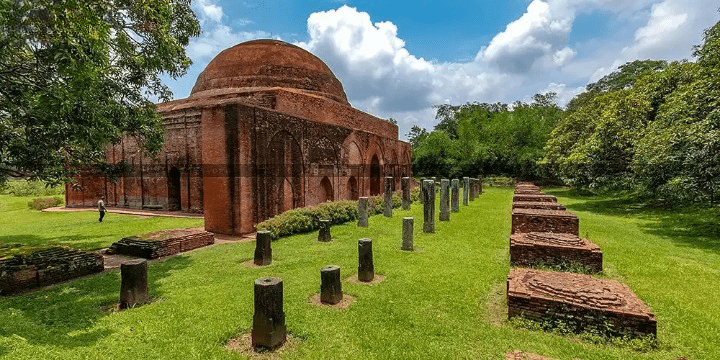Exploring the Rich Tapestry of Maldah District
Introduction
Maldah, often spelled Malda, is a district in the Indian state of West Bengal, renowned for its vibrant history, diverse culture, and rich geographical features. This article delves into the multifaceted aspects of Maldah, providing a comprehensive overview of its demography, culture, geography, cuisines, history, notable poets and authors, and administrative structure.
Demography of Maldah
Maldah district, with a population of over 4 million, is a melting pot of various ethnic and cultural groups. The district exhibits a balanced demographic profile with a near-equal distribution of male and female populations. The majority of the populace speaks Bengali, which is also the official language. There are significant communities of Hindi and Urdu speakers as well, reflecting the region's historical and cultural amalgamation.
Population Statistics
- Total Population: 4,073,000 (approx.)
- Male Population: 2,091,000
- Female Population: 1,982,000
- Literacy Rate: 62.71%
- Urban Population: 1,213,000
- Rural Population: 2,860,000
Cultural Heritage of Maldah
Maldah is a cultural treasure trove, where traditional customs coexist with contemporary practices. The district is known for its folk music, dance, and festivals that celebrate the local heritage.
Festivals
- Durga Puja: The grand celebration of the goddess Durga, marked by elaborate pandals and processions.
- Eid-ul-Fitr and Eid-ul-Adha: Celebrated with great fervor by the Muslim community, highlighting the district's communal harmony.
- Chhath Puja: A significant festival for the local Hindi-speaking population, devoted to the Sun God.
Folk Arts and Crafts
- Nakshi Kantha: Traditional embroidered quilts that reflect the artistic skills of local women.
- Terracotta Art: Maldah is known for its exquisite terracotta sculptures, a legacy of ancient craftsmanship.
Geography and Natural Beauty
Located in the fertile Gangetic plains, Maldah is blessed with a diverse landscape that includes rivers, forests, and agricultural lands. The district is bordered by Bangladesh to the east, Bihar to the west, and other West Bengal districts to the north and south.
Major Rivers
- Ganga River: The lifeline of Maldah, supporting agriculture and providing water resources.
- Mahananda River: Another significant river contributing to the district's irrigation and ecology.
Climate
Maldah experiences a tropical climate with hot summers, monsoon rains, and mild winters. The average temperature ranges from 25°C to 35°C in summer and 10°C to 20°C in winter.
Cuisine of Maldah
The culinary landscape of Maldah is a delightful blend of Bengali, Bihari, and Mughlai influences, offering a wide array of flavors and dishes.
Traditional Dishes
- Mango Delicacies: Maldah is famously known as the 'Mango City', producing varieties like Langra, Himsagar, and Fazli. Mango-based dishes and desserts are a staple.
- Fish Curry: A Bengali favorite, prepared with fresh river fish and a medley of spices.
- Litti-Chokha: A Bihari influence, this dish comprises baked wheat balls served with mashed vegetables.
Historical Significance
Maldah's history is deeply intertwined with the broader historical narratives of Bengal and India. It has been a significant center since ancient times, with remnants of its glorious past still visible.
Key Historical Sites
- Gour and Pandua: Once the capitals of Bengal, these ancient cities house remarkable ruins, including mosques, tombs, and gateways.
- Adina Mosque: Built in the 14th century, it is one of the largest mosques in India and a masterpiece of Indo-Islamic architecture.
- Dakhil Darwaza: A grand gateway from the 15th century, exemplifying the architectural grandeur of the Sultanate period.
Notable Poets and Authors
Maldah has produced several illustrious poets and authors who have contributed significantly to Bengali literature.
Prominent Literary Figures
- Rabindranath Tagore: Although not native to Maldah, his works have had a profound influence on the district's literary culture.
- Farrukh Ahmad: A celebrated poet from Maldah, known for his contributions to Bengali and Urdu literature.
Administrative Structure
The administration of Maldah is organized into several subdivisions and blocks, ensuring effective governance and development.
Administrative Divisions
- District Headquarters: English Bazar
- Subdivisions: Maldah Sadar, Chanchal
- Blocks: 15 administrative blocks, including Old Malda, Gazole, and Harishchandrapur.
Governance
The district administration is headed by the District Magistrate (DM), supported by various officers responsible for law and order, development, and welfare activities.
Conclusion
Maldah is a district that encapsulates the essence of Bengal's rich heritage, natural beauty, and cultural diversity. From its historical landmarks to its delectable cuisine, Maldah offers a unique blend of the past and present, making it a fascinating destination for historians, travelers, and cultural enthusiasts alike.
Suggested Diagram
This comprehensive exploration of Maldah district highlights its multifaceted character, promising to engage readers and provide a rich, informative experience.
